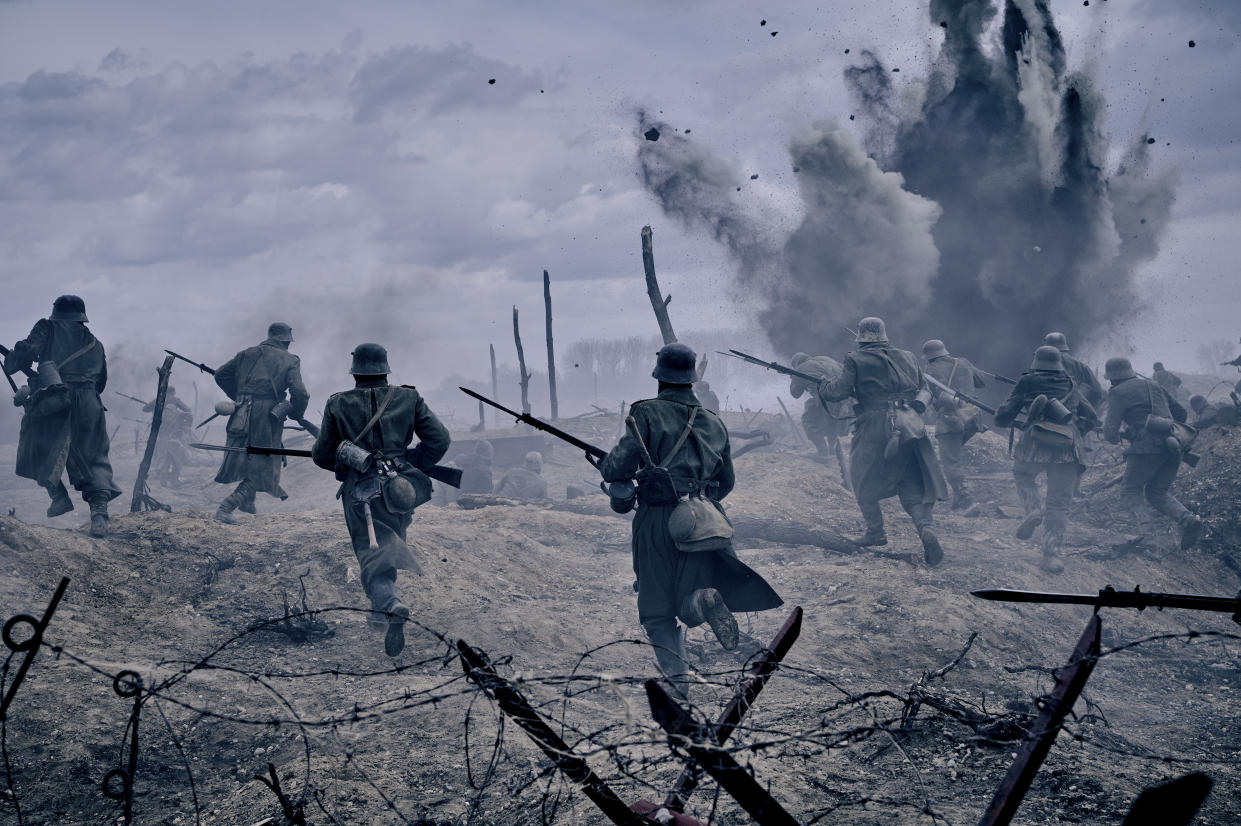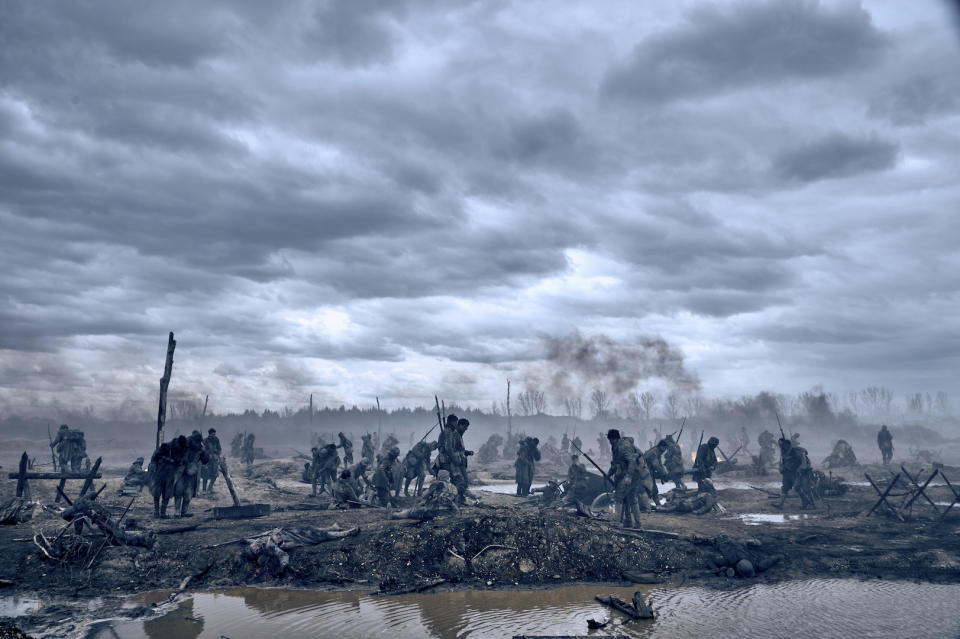2023 Oscars: Can ‘All Quiet on the Western Front’ Translate Its Surprising Momentum Into Craft Nominations?

- Oops!Something went wrong.Please try again later.
- Oops!Something went wrong.Please try again later.
- Oops!Something went wrong.Please try again later.
It’s been a big week for Netflix’s anti-war epic “All Quiet on the Western Front.” Edward Berger’s adaptation of Erich Maria Remarque’s world-renowned bestseller rolled into the final days of Oscar nominations voting with surprise crafts momentum, qualifying for four shortlists (makeup and hairstyling, score, sound, and VFX) along with the Best International Feature category as Germany’s submission. “All Quiet” then swept BAFTA nominations on Thursday, its 14 nominations equaling the record for a non-English-language feature set by “Crouching Tiger, Hidden Dragon” in 2001.
Beyond the shortlists, cinematographer James Friend is an Oscar contender, too, despite being overlooked as an ASC nominee. He received a BAFTA nomination as recognition of his bravura work in capturing the sheer scope of the unrelenting artillery attacks and massive carnage on the battlefield with large format cameras.
More from IndieWire
“All Quiet on the Western Front” re-imagines Remarque’s novel as an intense POV movie with long tracking shots, as we follow Paul (Felix Kammerer) from winter to spring in the harrowing final days of World War I. The visual and sonic crafts are essential in contributing to the visceral immediacy of the death and destruction that Paul experiences around him — akin to that of an immersive horror film.
But will the film come away with one or more Oscar nominations? The likeliest are MUAHS and sound, but the “All Quiet” presentation received praise at the VFX “bake-off” last Saturday, and composer Volker Bertelmann has previously received a nomination from his peers for “Lion” (under the name Hauschka and shared with Dustin O’Halloran).

Reiner Bajo
Makeup and Hairstyling
Makeup and hair designer Heike Merker immersed herself in the fine details of applying mud and blood to Paul and his fellow soldiers on the rain-soaked battlefield. She helped convey their journey into becoming sludge-caked, weary, demoralized soldiers. This entailed an assortment of wigs and lots of facial hair, and keeping track of the evolution of the war makeup and hair (especially since scenes were not shot in order).
Kammerer was painted with glazing gels and grease paint around his eyes and face (particularly after the horrific mustard gas attacks), and he had dry lips to make him look freezing. This was to illustrate how quickly young Paul has grown into a soldier. Crucially, there were many iterations of mud and dirt, in terms of textures, colors, and viscosity to build and chart the trajectory of the character makeup. The makeup and hair also had to depict Paul’s physical and mental state. He had to look thinner and more tired, and his teeth had to be darker (with the aid of teeth splints).
Score
Berger’s go-to composer Bertelmann provided an almost atonal score that reflects Paul’s emotional state as well as the horror-film vibe of war itself with acute, staccato drumbeats, along with a burst of sinister, spare chords. Interestingly, an iconic bass became the film’s leitmotif, and the composer built the entire score around it. While the drum evokes a military sound and history, Bertelmann carefully avoided marching band percussion; therefore, the snare drums were bullet-like by design: both unsettling and insistent.
Finally, for the the giant chords, Bertelmann found personal inspiration in his great grandmother’s refurbished harmonium. This keyboard instrument causes metal reeds to vibrate and when he played it, the composer used the instrument’s unique mechanics as part of the score, tricking it out with microphones to accentuate the sound.
Sound
The team of sound supervisor/sound designer Frank Kruse, co-sound designer Markus Stemler, and re-recording mixer Lars Ginzel created a soundscape that was immersive and haunting. They sourced what they could from the period, including the bellicose and noisy wardrobe — particularly metal helmets and spiked boots — which provided a trove of sounds for the team. However, not many other recorded sounds remain from World War I, so the soundscape was a combination of production sound and created sonics.
The research also revealed that the soldiers had a sonic relationship with the war. They often couldn’t see what hit them, but they could hear it, and that gave the various agents of death nicknames. For example, the machine gun was a sewing machine. This was utilized to great effect in the the scene where the whir of the sewing machine segues into a burst of gunfire.
Silence was important as well, and the variations of human breath or the smallest of gasps are as effective as the crash of bombs. Ultimately, the sound reflects Paul’s arc from enthusiastic young fighter to demoralized zombie.
Visual Effects
Production visual effects supervisor Frank Petzold took a naturalistic approach led by Friend’s principal photography, and the goal was to rely on as many photographic elements as possible for compositing. All locations and props were 3D scanned and modeled, to support the placement of the principal photographic elements with CG shadows and reflections. CG simulations were reserved for augmentation.
Explosions, meanwhile, were handled by the SFX team and shot at the former airfield location with the Red camera, then seamlessly comped into the background during the battle sequences. Indeed, smoke became a character of sorts, and it was hard to discern what was practical and what was digital. Curiously, yellow smoke from mustard gas was left a bit mysterious.
Tanks were a character as well. The appearance of the first machines of war were handled in 3D animation, since they wanted them to come across as gigantic creatures. But, as some of the close-up tanks were separately shot with SFX support by the Red camera, 3D animation was used to control the timing of the tank fleet as they break through the fog.
Best of IndieWire
Sign up for Indiewire's Newsletter. For the latest news, follow us on Facebook, Twitter, and Instagram.


